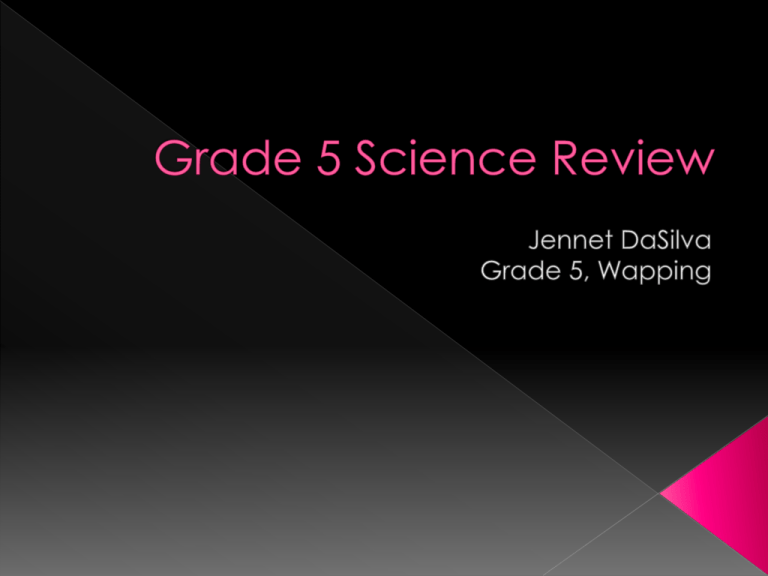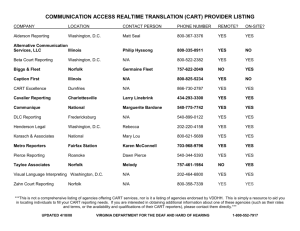Grade 5 Reviews - South Windsor Public Schools
advertisement

The position and motion of objects can be changed by a ….. pull A child and a teenager are riding down a hill. The child is on a tricycle and the teenager is on a bike. They are traveling at the same speed. You need to stop one of them. Which one will be easier to stop? Why? The child is easier to stop because he has less mass than the teenager. Think about the cart and washer experiment you did earlier this year. As the mass of the cart stayed the same and the number of washers pulling the cart increased, how was the speed of the cart affected? a. The speed decreased. b. The speed increased. c. The speed stayed the same. Cart and Washer Experiment 25 20 15 speed of cart 10 The speed of the cart increases because the strength of the pull increases. 5 0 0 2 4 # of washers pulling cart 6 If there are always four washers used to pull the cart and the mass of the cart increases, what will happen to the speed of the cart? a. The speed will decrease b. The speed will increase. c. The speed will stay the same. S p e e d o f C a r t Cart and Washer Experiment 16 14 12 10 8 speed of cart in/s 6 The speed will decrease because the mass of the cart is increasing and the strength of the pull is staying the same. 4 2 0 0 2 4 6 8 Number of Washers in the Cart 10 Your task is to pull a 2000 pound wagon of supplies in the least amount of time. You may choose one animal to help you. Will it be the elephant or the cow? Explain the effects its strength has on the motion of the wagon. Video camera binoculars telescope camera periscope microscope Describe the uses of each instrument and how it enhances our vision Light is a form of energy that travels in a straight line and can be reflected by a mirror, refracted by a lens, and absorbed by objects. Mirrors reflect light. Water refracts light. That is why the pencil appears to be bent. The color black absorbs light. White light is made of all the colors of the rainbow. They are ……. Red ======================= Orange ==================== Yellow ===================== Green ====================== Blue ======================= Indigo ===================== Violet ====================== ROYGBIV Red, Orange, Yellow, Green, Indigo and Violet are absorbed. >>>>>>>>>>>>>>>> Blue light is reflected off the blue balloon and travels to the eye. Which of the following best explains why Brandon creates a shadow? A. Brandon changes the color of sunlight hitting the ground. B. Brandon reflects sunlight onto the ground. C. Brandon bends light waves from the Sun. D. Brandon blocks light from the Sun. A child sees a mirror image of a lighthouse in the water. What causes this mirror image? a. Black light b. Refracted light c. Reflected light d. Absorbed light What happens to the path of a light ray as it passes from air into water at an angle? a. Its path bends. b. Its path becomes shorter. c. Its path continues in a straight line. A student places a sheet of black construction paper on her desk. What happens to most of the light that strikes the black construction paper? A. The light is bent by the paper. B. The light reflects off the paper. C. The light is absorbed by the paper. D. The light passes through the paper. Identify each object as opaque, transparent or translucent. Glass window transparent – all light travels through Frying pan opaque – no light travels through Desk opaque – no light travels through Paper towel translucent – some light travels through Tracing paper translucent – some light travels through Describe how light is absorbed. Describe how light is reflected. Describe how light is refracted. What colors make up white light? Explain why we see colors. The opening of the camera controls the amount of light allowed in. Which part of the eye does the same job? A. B. C. D. The lens The iris The retina The cornea A fair test experiment is when you design an experiment to compare two or more things. All conditions must be the same except for the two or more things you are comparing. What was being compared in the soggy paper experiment? We compared the absorbency of different types of paper. Same size paper squares Let each square drip the same amount of time. Use the same amount of water for each type of paper. Use the same tools for testing each type of the paper. (plastic plate, tweezers, plastic cup) Some students did an experiment to find out which type of paper holds the most water. They repeated the experiment 3 times, counting the number of squares used. Their data is shown in the table below. Number of Squares Needed to Absorb 25 Milliliters of Water Type of Paper Test 1 Test 2 Test 3 Paper Napkin 12 13 11 Paper Towel 6 5 7 Tissue 10 8 9 What should the students do next to answer their question? a. Show all the numbers in a bar graph. b. Show all the numbers in a pile chart. c. Find the average number of squares for each paper type. d. Find the highest number of squares used in Test 1, 2, or 3. What was being compared or tested in the Catch It unit? We compared the reaction times of different people in the class. Physical changes occur when objects undergo a change that does not change their chemical nature. A physical change involves a change in physical properties. Physical properties can be observed without changing the type of matter. Examples of physical properties include: texture, shape, size, color, odor, volume, mass, weight, and density. Carving wood is an example of a physical change. Discuss how the following properties are changing? Texture Shape Size Weight Properties of matter – has mass and takes up space. Identify the following as a solid, liquid or gas. Discuss how it has mass and takes up space. Chocolate is a solid. It has a definite shape and size. Helium in the balloon is a gas. It takes up Space in the balloon. Milk is a liquid. It takes the shape of its container. A. length B. pattern C. shape D. volume That is correct. It will harden and change back to a solid because heat was taken away. This is an example of a physical change. The substance is still chocolate whether it is on the stove or in the refrigerator. The only things that have changed are its physical properties. In this picture a chemical change took place when vinegar and baking soda were poured into a bottle. The balloon was placed on top and blown up. What evidence tells you a chemical change took place? Iron oxide or rust forms on an iron nail that has been outside and exposed to rain. The iron in the nail chemically reacts with the oxygen in the rain to form a new substance which is iron oxide or the solid rust. A chemical change has taken place!!!! Evaporation is when water passes from a liquid phase to a gas phase. Rates of evaporation of water depend on things like the temperature, humidity, and wind. The water in the teapot is an example of a liquid. When heat is added, steam is formed which is an example of a gas. This whole process is evaporation. A statue and a table are both made of the same type of marble. Which of the following physical properties will most likely be the same for both of these objects? A. size B. shape C. weight D. hardness The picture below shows a frozen juice bar. The frozen juice bar was placed on a table and left to melt. Which of the following properties of the juice bar will change the most once it melts? A. color B. mass C. shape D. volume Which of the following statements describes one way that solids are different from liquids? A. Solids have weight and liquids do not. B. Solids take up space and liquids do not. C. Solids have a definite shape and liquids do not. D. Solids have a definite volume and liquids do not. Which of the following statements best explains why the water changed to ice? A. The water gained energy. B. The water absorbed light. C. Mass was released from the water. D. Heat was taken away from the water. Water is commonly found on Earth in three states of matter: solid, liquid, and gas. In everyday life, water often changes from one form to another form. A. Describe one example of water changing from a liquid to a solid. B. For the example you gave in part (a), explain what caused this change. C. Describe one example of water changing from a liquid to a gas. D. For the example you gave in part (c), explain what caused this change.






